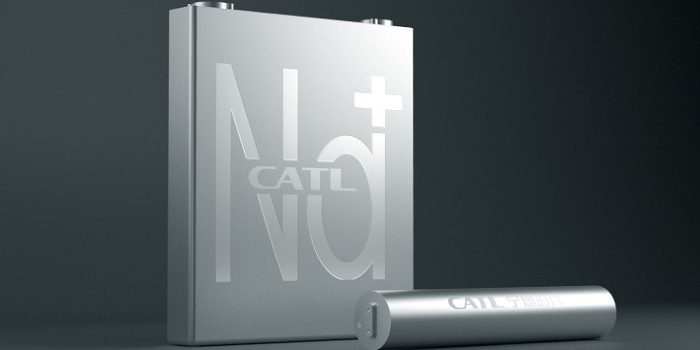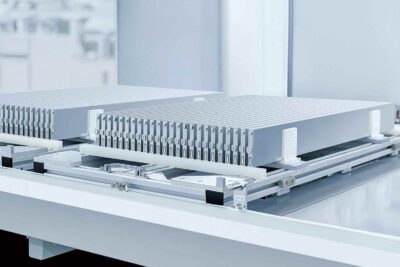Sodium over lithium: The low-cost alternative to Li-ion batteries
CATL has presented a sodium-ion cell along with plans to start production in 2023. What are the advantages and disadvantages of replacing lithium? Christoph M. Schwarzer evaluated the technology by speaking to battery experts from P3 Automotive and Prof. Dr Markus Hölzle from ZSW. The potential is huge!
* * *
Contemporary Amperex Technology Ltd. (CATL) has made a “breakthrough” with the establishment of basic production for sodium-ion cells, according to its own reading. And indeed, the replacement of the alkali metal lithium by the next element of this main chemical group would be the opportunity for further clear cost reduction. Therefore, our contributor talked to the battery professionals of P3 Automotive and Prof. Dr Markus Hölzle of ZSW (Center for Solar Energy and Hydrogen Research Baden-Württemberg) to come to a realistic assessment of sodium-ion cells.
CATL itself gets specific in the presentation: the Chinese company shows the actual cell and a battery system. It mixes lithium and sodium-ion cells to compensate for first-generation weaknesses. For example, CATL claims a comparatively low gravimetric energy density of 160 Wh/kg. The next generation is expected to exceed 200 Wh/kg; CATL has yet to say when.
Hard carbon anode
“The CATL developers must have succeeded in solving the known problems of sodium-ion cells, which are not new in principle,” explains Markus Hölzle. Hölzle, who holds a doctorate in electrochemistry and worked for BASF for a long time and internationally before joining ZSW, continues: “For example, 20 per cent of the capacity has so far been lost during the very first charge,” says Hölzle. CATL has probably been able to significantly improve the amorphous carbon on the anode side, the so-called hard carbon, in terms of irreversible losses and fast-charging capability. It can therefore be assumed that materials research has been a success here.
“On the cathode side, Prussian blue, a non-toxic dye, is used in a state completely mixed with sodium ions,” Professor Hölzle explains further. The advantage: “Low-cost raw materials are used throughout.” Not only lithium but also the typical cathode metals such as nickel and cobalt are eliminated. Despite the disadvantages, such as low energy density, Hölzle can imagine sodium-ion cells in all classes of vehicles because the auto industry is always paying close attention to the trade-off between costs and benefits. But even more interesting and closer in time would be stationary applications such as battery storage for solar systems because energy density plays only a minor role in these applications. With low-cost sodium-ion batteries, large battery storage systems could be realized at acceptable prices.
His conclusion: “I suspect that CATL will actually go into series production. The company is by far the market leader in China and has the clear goal of becoming the global champion in batteries. To this end, several hundred scientists are working in the group’s own research department at its headquarters in Ningde, China. Given CATL’s size and reputation, it is unlikely that it is exaggerating here,” says Markus Hölzle.
Competition from low-cost LFP cells
The consulting firm P3, which truly benchmarks every cell available, broadly confirms the view of ZSW. P3 cites three advantages of sodium versus lithium-ion cells: They are more powerful in terms of charge and discharge performance and thus offer advantages for applications with high power requirements, such as onboard batteries, small vehicles and stationary storage for power grids with high power requirements, among others. However, they are not yet a good enough fit for electric cars, according to P3. They have top-notch low-temperature performance. And their lifetime and thermal stability, i.e. safety, is very high. “But because the energy density is not comparable to current lithium-ion batteries with NCM cathode, the core competitive technology is LFP,” the consultancy concludes.
This needs a brief explanation: With few exceptions, lithium-ion cells with a cathode of nickel, cobalt and manganese were and are used in battery-electric cars. Although the mixing ratio at the cathode has changed permanently, the basic structure is similar. Tesla has been selling the Model 3 SR+ with a lithium iron phosphate battery for just under a year. This cell chemistry is extremely robust, allows tight packaging in the system and has very high cycle stability.
Because cobalt and nickel can be dispensed with, the price drops. On the other hand, there are disadvantages such as a shorter range due to the lower energy density – which is why the Model 3 is Standard Range Plus and not Long Range – and poor performance in cold conditions. Nevertheless, Tesla is rumoured to be deploying the second generation of LFP cells as early as the end of the year. The winter will show what improvements have been made.
No industrial-scale application so far
Back to P3’s assessment of sodium-ion batteries: the degree of maturity so far is low, he said, because a sober look reveals that there is no application on a large industrial scale. “Quite a few startups from Faradion in the UK, Altris in Sweden or Tiamat in France are trying to commercialize this technology,” P3 said. None has succeeded yet.
If successful, the cost advantage could be ten to 20 per cent compared to LFP: “The significantly higher availability of sodium as well as its simpler and more environmentally friendly extraction and the elimination of cobalt and nickel in the cathode material can lead to a significant reduction in cell costs.” P3 believes that an application in motor vehicles is also possible, but for the time being the trend is toward stationary storage.
Utilising existing production processes
The reality of use in a mass-produced electric car could nevertheless come sooner than that of solid-state batteries: “It is estimated that the corresponding level of maturity for large-scale industrialization will be reached more quickly than, for example, by All Solid State, because due to the drop-in technology (same production technologies and similar material combinations as for lithium-ion batteries) the scalability can be classified as relatively high.
Neither ZSW nor P3 are currently committing to a price. Optimists, however, assume a cost of $30 per kilowatt-hour. CATL is very likely to produce sodium-ion cells in the period from or after 2023. At the same time, more electric cars with LFP cells will be coming to market in Germany. Volkswagen, for example, has already specified this for its entry-level ID.1 and ID.2 models. So, because of their better performance and even lower cost, while being more environmentally friendly, sodium-ion cells could become a competitor to LFP in the second half of the decade. As always with batteries, there is no cause for euphoria. But there is reason to be confident: at the moment, cost reduction is the most important aspect of electromobility’s global ramp-up.
Reporting by Christoph M. Schwarzer, Germany. Edit & translation by Nora Manthey, UK.





10 Comments